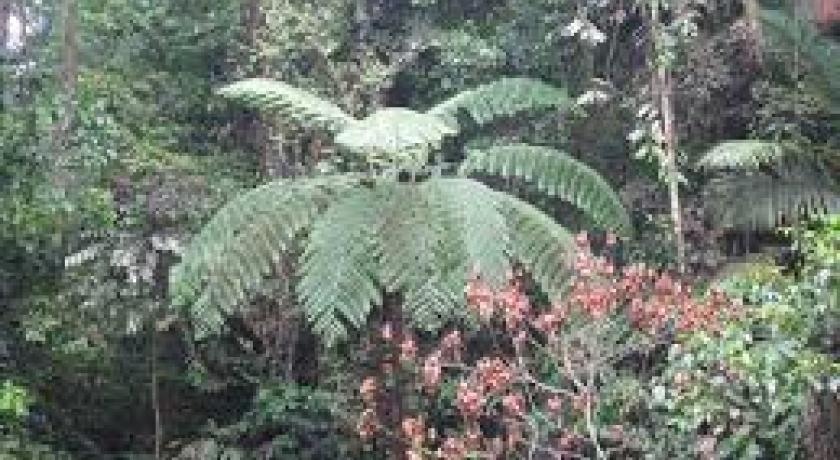Description
Krau Wildlife Reserve is the largest wildlife reserve covering 60,349 ha located in the Titiwangsa Mountains, central state of Pahang, Malaysia that was established during the British Colonial Administration. It is managed by the Department of Wildlife and National Parks, located south of Lanchang Township. In the 1960s, Lord Medway led a zoological expedition to Gunong Benom (2110 m ASL) which latter had attracted many scholars, biologists and primatelogists to conduct research on the eastern part of the reserve called Kuala Krau.
Mamal Research and Study
Set up in 1924, the Krau Wildlife Reserve is the second most important protected area in Peninsular Malaysia after Taman Negara, covering 520 square kilometers (200 square miles). Research on Siamang, the big black gibbon, began in 1968 and many other studies since then have concentrated on White-handed Gibbons, Banded and Dusky Leaf-monkeys, pheasants, mousedeer, macaques, bats and squirrel.
Gunung Benom, the big, lumpy dome of granite that forms the northwest corner of the reserve, is the sixth highest peak in the Peninsular. Krau Wildlife Reserve extends down the eastern and southern slopes of the mountain, reaching the lowlands along the Sungai Krau and Sungai Lompat. It is at the junction of these two rivers that most work has been done, at the research station of Kuala Lompat. The department of Wildlife and National Parks maintains a ranger post at Kuala Lompat and another at Kuala Gandah where the Elephant Translocation Unit is based. Nearby are breeding stations for the seladang or Gaur (huge wild cattle), and local deer. The ranger post at Kuala Lompat provides accommodation for researchers working in tall, undisturbed, very productive forest. From here, a network of trails extends through the first few square kilometers of the reserve.
The lowland dipterocarp forest area contains very high diversity of birds and mammals especially primates and bats. At Kuala Gandah, is the Elephant Centre for the management of displaced animals. At Jenderak is the breeding centre for seladang (Bos gaurus)Indian bison. Among the birdlife, the rare Malayan peacock-pheasant is still found in the reserve in some numbers.
The frequently flooding alluvial habitat is rich in big trees of the bean family, which tend to produce edible and nutritious fruits and leaves. These, together with the large number of fig trees, are probably one of the main reasons why monkeys are so abundant.
There used to be some magnificent examples of the big strangling figs with their cathedral-like flying buttress roots – often a sign of previous forest disturbance – and these were common near the rivers because this area used to be settles by Jah Hut people. Most of these people later settled in permanent villages just outside the reserve and the forest around Kuala Lompat were able to recover gradually, with the abundance of fig trees showing where the earlier disturbance had been.
The Forest Bird Community
About 190 species of birds have been recorded so far. Important ones include the Giant Pitta, Malaysian Peacock Pheasant and White-belllied Woodpecker. There is a wide variety of owls and frogmouths, including the Large Frogmouth, a rarity. On the ground are Crested Wood Patridges and Crested Fireback Pheasants, while in the canopy there can be found up to eight species of hornbills, many bulbuls, barbets, pigeons, broadbills, leafbirds, sunbirds – in fact a complete lowland forest bird community.
Gunung Benom
For serious researchers who qualify for access to the reserve, Kuala Lompat is not the only place of interest. One long day is enough to reach the villagers of the Che Wong people in the centre of the reserve, and from here at the base of Gunung Benom a trail leads up to the granite outcrop of Batu Gambar Orang.
The peak of Gunung Benom can also be reached from the northeastern boundary of the reserve near Kampung Ulu Cheka. From the summit at 2,107 meters (6,913 feet), on a clear day, Fraser’s Hill and the entire Main Range can be seen to the west, and the Peninsula’s highest peak, Gunung Tahan in far-off Taman Negara, blue and trembling in the heat-haze.
When to go:
Good in most seasons, but especially February- September, perhaps best for bird watching in April-June.
Access:
By road (car, taxi or bus) from Kuala Lumpur towards Temerloh; turn north towards Jerantut (a change of bus or taxi will be needed in Temerloh), but ask to be deposited at the village of Kuala Krau. Cars can drive direct to base camp at Kuala Lompat; if using public transport, ask for assistance at Kuala Krau.
Permits:
Normally open only to serious researchers; a permit must be obtained from the Dept. of Wildlife and National Parks in Kuala Lumpur a few days before you visit.
Equipment:
Light clothing, strong walking shoes and a poncho. Take food and other light supplies into the reserve with you (candles, matches, insect repellent are all good ideas). Sleeping bag may be useful.
Facilities: Simple housing available for small numbers, but not suitable for large groups. A good network of trails.
Source: https://en.wikipedia.org/wiki/Krau_Wildlife_Reserve
http://malaysia-eco-tourism.blogspot.com/2011/12/krau-wildlife-reserve.html
Address
Temerloh District
Maleisië
Lat: 3.605536461 - Lng: 102.052474976




